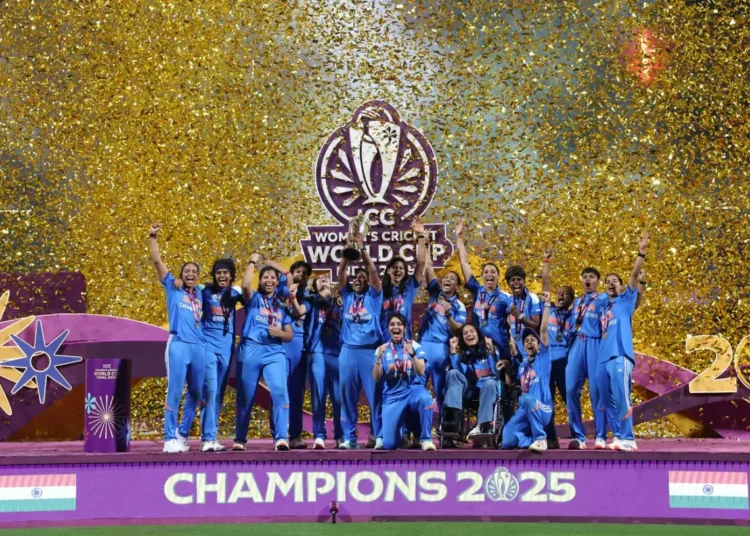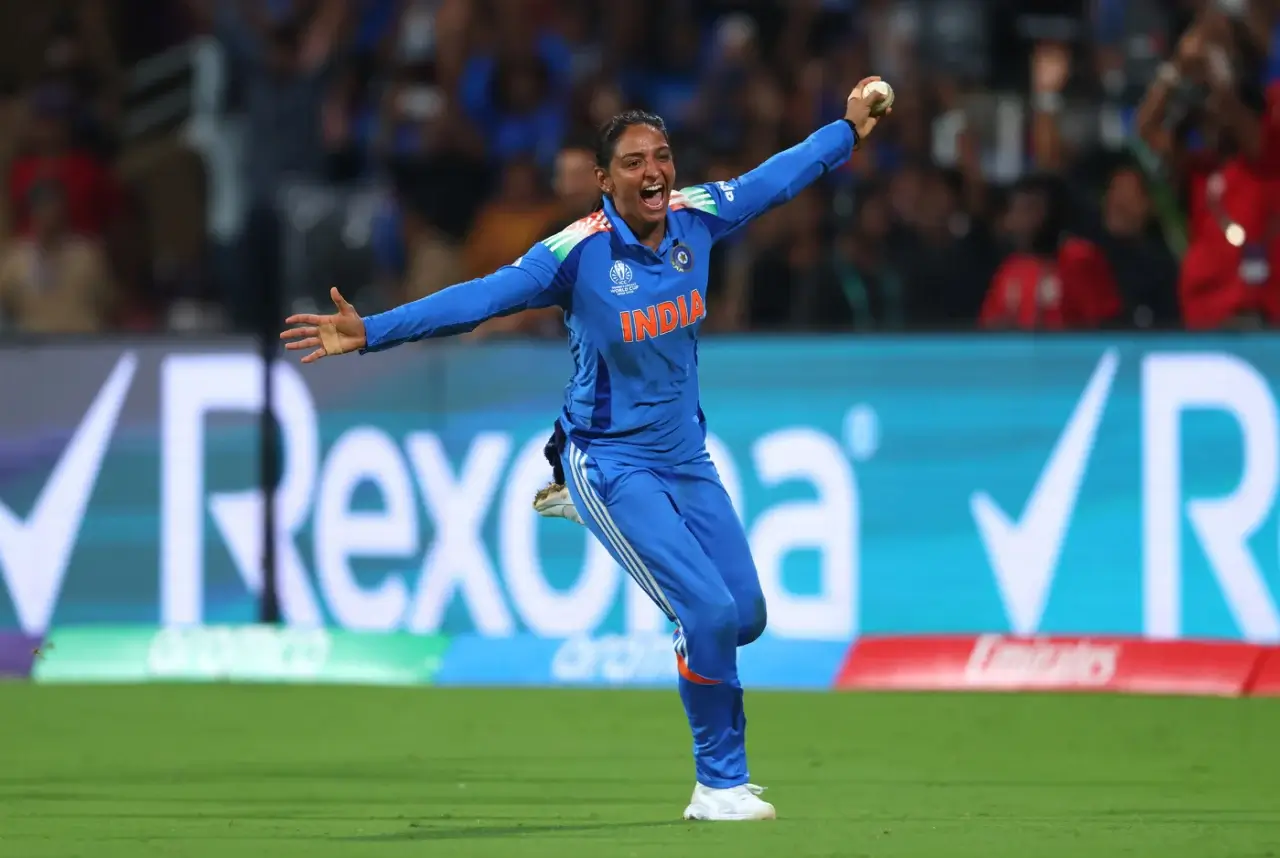At Navi Mumbai’s DY Patil Stadium, belief turned into history. India lifted their first ICC Women’s World Cup trophy after beating South Africa by 52 runs. It was not just a victory but a story built on intuition, courage, and perfect timing. Harmanpreet Kaur’s gut decision to let Shafali Verma bowl changed everything.
Shafali had already dominated with the bat, smashing 87 off 78 balls in her finest ODI innings. When South Africa began their chase confidently, Harmanpreet followed her heart. She threw the ball to Shafali, who had barely bowled in international cricket. Within minutes, Shafali produced two breakthroughs that tilted the match completely. The crowd erupted as she removed Sune Luus and Marizanne Kapp in successive overs, like against Australia.
From that moment, India held the game in their grasp. Deepti Sharma added calm assurance with a half-century and five wickets. Together, they scripted India’s biggest triumph on home soil. The win symbolized more than talent; it showed trust, instinct, and unity. India didn’t just win a final — they announced themselves as the best in the world.
Harmanpreet’s fearless instinct that turned the game
Captain Harmanpreet Kaur has built her leadership on emotion and trust. When South Africa’s chase looked settled at 120 for 2, she sensed a shift. She looked at Shafali Verma standing at cover, calm and confident after her brilliant knock. In that instant, she made the most decisive call of her captaincy.
Shafali had bowled only 14 overs in 30 ODIs before this match. Yet Harmanpreet believed her energy was special that day. “I knew it was her day,” she said later. Shafali took just two balls to remove Sune Luus, diving forward for a sharp return catch. Her next over sent Marizanne Kapp back, strangled down the leg side.
Those two wickets shifted momentum and silenced the South African dugout. The stadium came alive, and India’s bowlers lifted instantly. It was a moment of pure instinct that defined a champion leader’s courage.
Why intuition beats numbers in big matches?
Great captains read the game beyond analytics. Harmanpreet trusted her observation more than statistics. She saw rhythm, body language, and intent in Shafali’s confidence. That one moment of faith broke South Africa’s rhythm and built India’s belief. Finals reward bold choices, and this was leadership at its finest.
Shafali Verma’s fearless double act redefines India’s rise
When Shafali Verma walked out to open, she carried freedom and aggression. Her batting combined power and placement in perfect harmony. She scored 87 off 78 balls, her highest in World Cups. Every shot echoed confidence — drives, flicks, and lofted hits clearing the field with ease.
Partnering Smriti Mandhana, she helped India reach 104 without loss in just 16 overs. Her timing frustrated South Africa’s new-ball pair, forcing defensive fields early. The moment Smriti fell, Shafali slowed down briefly but continued attacking smartly. She was eventually dismissed while trying to go big, but her job was done.
Then came her surprise role with the ball. She picked two vital wickets in the middle overs and turned the game again. Her all-round show — runs, wickets, and energy — earned her the Player of the Match. It was a day when potential transformed into history.
The evolution of Shafali from hitter to match-winner
Shafali has long been known for fearless stroke play. But in this tournament, she became a mature performer who reads situations better. Her bowling showed calmness under pressure and her batting showed intelligence. She no longer plays for moments; she plays for matches — that’s true growth.
Deepti Sharma’s calm dominance seals India’s dream
Deepti Sharma continues to be India’s most dependable all-rounder. Her 58 with the bat gave India stability after the openers departed. She rotated strike smartly, found gaps, and stitched key partnerships to push the total close to 300. Her understanding of tempo gave India control when the innings slowed down.
Then she did what she always does — deliver under pressure. Her 5/39 dismantled South Africa’s middle and lower order. She bowled with clever variations, mixing flight, dip, and pace to perfection. The dismissal of Laura Wolvaardt for 101 broke South Africa’s hopes completely.
Every over from Deepti was a masterclass in patience and precision. She bowled like a veteran reading every batter’s move. It wasn’t aggression that won the game, it was intelligence. She rightly earned the Player of the Series award for her unmatched consistency.
What makes Deepti India’s most complete player?
Deepti’s game is built on reading conditions faster than opponents. She knows when to attack, when to defend, and when to surprise. Her ability to balance both roles — anchor and aggressor — makes her unique. She brings balance to India’s lineup like few others in world cricket.
Tactical intelligence — how India built a complete performance
India’s 298 looked modest, but it was a perfectly planned total. The openers attacked early, the middle built rhythm, and the finishers ensured stability. When South Africa chased, India controlled the tempo smartly across phases.
Renuka Singh swung the ball beautifully in the powerplay, creating early edges. Radha Yadav and Shafali worked together to squeeze runs in the middle overs. Fielding intensity was high, with Amanjot Kaur’s juggling catch sealing Wolvaardt’s fate. Every player had a role, and every moment felt calculated.
The team adapted brilliantly to the pitch and overhead conditions. They bowled tight lines, used cutters effectively, and never allowed free scoring. It was a tactical masterclass that reflected preparation and composure. India didn’t dominate through luck; they executed with precision and intent.
The power of flexible strategy in modern finals
Modern cricket rewards adaptability more than aggression. India rotated bowlers smartly and used match-ups at perfect times. They never panicked under pressure, even when Wolvaardt scored freely. This flexibility and calmness are what separate champions from challengers.
From heartbreaks to history — India’s golden night at DY Patil
This win holds meaning far beyond statistics. It’s the completion of a journey that began with heartbreaks in 2017 and 2022. Those losses became lessons that shaped India’s 2025 triumph. This team didn’t stumble again; they learned, evolved, and conquered.
The victory reflects maturity across all departments — batting, bowling, and fielding. It also marks the growth of India’s bench strength and belief in young players. Cricketers like Jemimah Rodrigues and Radha Yadav carried composure beyond their years. Veterans like Harmanpreet and Deepti guided with experience and assurance, winning their first world cup.
For fans tracking India’s growth, history connects beautifully across rivalries. You can trace this journey through the India vs Bangladesh timeline, which shows how consistent structure built a world-class team. India vs Bangladesh Timeline → This victory isn’t a one-off; it’s the product of years of progress.
The beginning of a new era in women’s cricket
India’s success will inspire thousands of young girls to dream bigger. This moment proves that talent combined with opportunity creates champions. It also confirms that Indian women’s cricket has entered a new era. The DY Patil win is not the end — it’s the start of something greater.
CONCLUSION
As confetti filled the Navi Mumbai night, joy mixed with disbelief. India were finally World Champions. Harmanpreet Kaur’s instinct, Shafali Verma’s brilliance, and Deepti Sharma’s control had completed the fairytale. The moment wasn’t just about cricket; it was about belief realized on the biggest stage.
The final was full of pressure, but India stood taller every minute. Their teamwork reflected preparation, discipline, and composure under the brightest lights. It wasn’t power that won it; it was clarity and courage. Harmanpreet’s decision-making embodied what leadership should be — bold and intuitive.
This win will change how the world views Indian women’s cricket. It brings validation to years of effort and sets a new global benchmark. Every fan, young or old, will remember where they were when history changed. The victory at DY Patil marks not an ending, but a beginning — of dominance, confidence, and belief. India didn’t just lift a trophy. They lifted an entire generation’s dream.







